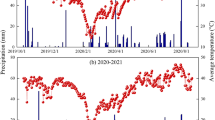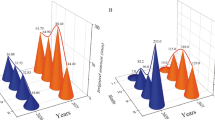Abstract
The individual and combined effects of biochar (B) and inorganic fertiliser (F) have all been widely proofed to improve soil fertility and enhance crop growth and yield under irrigation (I) and rain fed conditions. However, the strength of their individual and combined effects on crop productivity has been scarcely reported. In addition, few studies have assessed their individual and co-application effects on economic returns. Therefore, a 2-year field experiment which consisted of factorial combination of irrigation (I) [100% full irrigation (FI), 80% FI and 60% FI], biochar (0 and 20 t/ha) and fertiliser (0 and 300 kg/ha) was conducted. According to the results, irrigation was the dominant factor that influences maize grain yield, followed by inorganic fertiliser and biochar, and they were all significant in their main effects. The strength of interaction effects among, I, F and B on maize grain yield follow the sequence F × I > B × F > B × I. The economic analysis showed that the ternary combination of B, F and I was more economical than the binary combination of B plus I, and F plus I (in that order), when compared with the standalone application of I at maximum production in the field experiment. In addition, combined applications of biochar and fertiliser improved soil nutrients, nutrient uptake in all irrigation treatments, compared to the standalone applications of biochar or fertiliser. Further research is, therefore, recommended for long-term evaluation of the economic viability of integrating biochar with fertiliser under irrigation.





Similar content being viewed by others
References
Agbato SO (2003) Principles and practices of crop production. Odumatt Press Publisher, Oyo, pp 57–62
Agbna GHD, Dongli S, Zhipeng L, Elshaikh NA, Guangcheng S, Timm LC (2017) Effects of deficit irrigation and biochar addition on the growth, yield, and quality of tomato. Scientia Hort 222:90–101
Ajayi AE, Horn R (2016) Modification of chemical and hydrophysical properties of two texturally differentiated soils due to varying magnitudes of added biochar. Soil Tillage Res 164:34–44
Ajayi AE, Holthusen D, Horn R (2015) Changes in microstructural behaviour and hydraulic functions of biochar amended soils. Soil Tillage Res 155:166–175
Akhtar SS, Guitong L, Mathias NA, Fulai L (2014) Biochar enhances yield and quality of tomato under reduced irrigation. Agric Water Manag 138:37–44
Asai H, Samson BK, Stephan HM, Songyikhangsuthor K, Homma K, Kiyono Y, Inoue Y, Shiraiwa T, Horie T (2009) Biochar amendment techniques for upland rice production in Northern Laos 1. Soil physical properties, leaf SPAD and grain yield. Field Crops Res 111:81–84
Carsky RJ, Iwuafor ENO (1995) Contribution of soil fertility research and maintenance to improved maize production in sub-saharan Africa. In: Proceedings of regional maize workshop. International Institute of Tropical Agriculture (IITA), Cotonou, Benin
Chan KY, Van Zwieten L, Meszaros I, Downie A, Joseph S (2008) Agronomic values of greenwaste biochar as a soil amendment. Soil Res 45(8):629–634
Dutt S (2005) A handbook of agriculture. ABD Publishers, Jaipur, pp 116–118
Faloye OT, Alatise MO, Ajayi AE, Ewulo BS (2017) Synergistic effects of biochar and inorganic fertiliser on maize yield in an alfisol under drip irrigation. Soil Tillage Res 174:214–220
Faloye OT, Alatise MO, Ajayi AE, Ewulo BS (2019) Effects of biochar and inorganic fertiliser applications on growth, yield and water use efficiency of maize under deficit irrigation. Agric Water Manag 217:165–178
FAO (1998) Crop evapotranspiration: guidelines for computing crop water requirements. Allen RG, Pereira LS, Raes D, Smith M (eds) Irrigation and drainage paper 56. Rome, Italy
Fasinmirin JT, Reichert JM, Ajayi AE (2014) Leaf chlorophyll and biomass yield of greenhouse tomato (Lycopersicon esculentum Mill) under different urea application rates. In: Proceedings of the 2014 international conference of the Nigerian Institution of Agricultural Engineers. Federal University of Technology, Akure, Nigeria, pp 154–161
Food and Agricultural Organisation of the United Nations (FAO) (2018) FAO food price index. Food and Agriculture Organization (FAO) (2000) production year book, vol 54. http://www.fao.org/worldfoodsituation/foodpricesindex/en/2018. Accessed 10th Jan 2019
Gheysari M, Loescher HW, Sadeghi SH, Mirlatifi SM, Zareian MJ, Hoogenboom G (2015) Water-yield relations and water use efficiency of maize under nitrogen fertigation for semiarid environments: experiment and synthesis. In: Sparks DL (ed) Advances in agronomy. Elsevier, USA, pp 175–229
Guerena D, Lehmann J, Hanley K, Enders A, Hyland K, Enders A, Hyland C, Riha S (2013) Nitrogen dynamics following field application of biochar in a temperate North American maize-based production system. Plant Soil 365:239–254
Gwenzi W, Chaukura N, Mukome FN, Machado S, Nyamasoka B (2015) Biochar production and applications in sub-Saharan Africa: opportunities, constraints, risks and uncertainties. J Environ Manag 150:250–261
International Institute of Tropical Agriculture (IITA) (2014) Maize seed production manual. http://www.iita.org. Accessed 6 Oct 2015
Karhu K, Mattila T, Bergström I, Regina K (2011) Biochar addition to agricultural soil increased CH4 uptake and water holding capacity—results from a short-term pilot field study. Agric Ecosyst Environ 140:309–313. https://doi.org/10.1016/j.agee.2010.12.005
Kolton M, Harel YM, Pasternak Z, Graber ER, Elad Y, Cytryn E (2011) Impact of biocharapplication to soil on the root-associated bacterial community structure of fully developed greenhouse pepper plants. Appl Environ Microbiol 77:4924–4930
Krull ES, Skjemstad JO, Baldock JA (2004) Functions of soil organic matter and the effect on soil properties. Grains Research and Development Corporation report, project CSO 00029. http://www.grdc.com.au/growers/res_summ/cso00029/contents.htm. Accessed Nov 2016
Laghari M, Hu Z, Fazal M, Hu M (2015) Effects of biochar application rate on sandy desert soil properties and sorghum growth. CATENA 135:313–320
Lawlor DW, Lemaire G, Gastal F (2001) Nitrogen, plant growth and crop yield. In: Lea PJ, Morot-Gaudry JF (eds) Plant nitrogen. Springer, Berlin, pp 343–367
Lehmann J (2007) Bio-energy in the black. Front Ecol Environ 5:381–387
Lehmann J, Da Silva Jr J P, Steiner C, Nehls T, Zech W, Glaser B (2003) Nutrient availability and leaching in an archaeological Anthrosol and a Ferralsol of the Central Amazon basin: fertiliser, manure and charcoal amendments. Plant Soil 249(2):343–357
Lehmann J, Gaunt J, Rondon M (2006) Bio-char sequestration in terrestrial ecosystems a review. Mitig Adapt Strateg Glob Change 11:403–427
Liu Z, Dugan B, Masiello CA, Gonnermann HM (2017) Biochar particle size, shape, and porosity act together to influence soil water properties. PLoS One 12(6):e0179079
Major J, Steiner C, Downie A, Lehmann J (2009) Biochar effects on nutrient leaching. In: Lehmann J, Joseph S (eds) Biochar for environmental management: science and technology. Earthscan Publishers Ltd., London, pp 271–287
Major J, Rondon M, Molina D, Riha SJ, Lehmann J (2010) Maize yield and nutrition during 4 years after biochar application to a Colombian savanna oxisol. Plant Soil 333:117–128. https://doi.org/10.1007/s11104-0100327-0
Mando A, Ouattara B, Sedogo M, Stroosnijder L, Ouattara K, Brussaard L, Vanlauwe B (2005) Long-term effect of tillage and manure application on soil organic fractions and crop performance under Sudano-Sahelian conditions. Soil Tillage Res 80:95–101
Mete FZ, Mia S, Dijkstra F, Abuyusuf A, Hossain ASMI (2015) Synergistic effects of biochar and NPK fertiliser on soybean yield in an alkaline soil. Pedosphere 25(5):713–719
Ndor E, Dauda SN, Azagakui ED (2015) Response of maize varieties (Zea mays) to biochar amended soil in Lafia, Nigeria. Am J Exp Agric 5(6):525–531
Oguntunde PG, Fosu M, Ajayi AE, Van de Giesen N (2004) Effects of charcoal production on maize yield, chemical properties and texturel. Biol Fertil Soils 39:295–299
Oslen SR, Cole CV, Watanabe FS, Dean LA (1954) Estimation of available phosphorus in soils by extraction with sodium bicarbonate. United States Department of Agriculture Circular, p 939
Peng Y, Li X, Li C (2012) Temporal and spatial profiling of root growth revealed novel response of maize roots under various nitrogen supplies in the field. PLoS One 7:e37726
Petter FA, Madari BE, Silva MAS, da Carneiro MAS, Carvalho MTM, Marimon JBH, Pacheco LP (2012) Soil fertility and upland rice yield after biochar application in the carrado. Pesaisa Agropecuaria Brasileira 47:699–706
Setiyono TD, Cassman KG, Specht JE, Dobermann A, Weiss A, Yang H, Conley SP, Robinson AP, Pedersen P, De Bruin JL (2010) Simulation of soybean growth and yield in near-optimal growth conditions. Field Crop Res 119:161–174
Sohi S, Krull E, Lopez-Capel E, Bol R (2010) A review of biochar and its use and function in soil. Adv Agron 105:47–82
Steiner C, Teixeira WG, Lehmann J, Nehls T, Mace Do JLV, Blum WEH, Zech W (2007) Long term effects of manure, charcoal and mineral fertilization on crop production and fertility on a highly weathered Central Amazonian upland soil. Plant Soil 291(1):275–290
Tenenbaum DJ (2009) Bio-char: carbon mitigation from the ground up. Environ Health Perspect 117:70–73
Topoliantz S, Ponge JF, Ballof S (2005) Manioc peel and charcoal: a potential organic amendment for sustainable soil fertility in the tropics. Biol Fertil Soils 41:15–21
UNDESA (United Nations Department of Economic and Social Affairs, Population Division) (2009) World population prospects: the 2008 revision, highlights. Working paper no. ESA/P/WP.210. UN, New York
Uzoma KC, Inoue M, Andry H, Fujimaki H, Zahoor A, Nishihara E (2011) Effect of cow manure biochar on maize productivity under sandy soil condition. Soil Use Manag 27(2):205–212
Woolf D, Amonette JE, Stree-Perrott FA, Lehmann J, Joseph S (2010) Sustainable biochar to mitigate global climate change. Nat Commun 1:56
Zhang F, Yin G, Wang Z, McLaughlin N, Geng X (2013) Quantifying spatial variability of selected soil trace elements and their scaling relationships using multifractal techniques. PLoS One 8(e69326):9
Zou C, Gao X, Shi R, Fan X, Zhang F (2008) Micronutrient deficiencies in crop production in China. In: Alloway BJ (ed) Micronutrient deficiencies in global crop production. Springer, Amsterdam, pp 127–148
Acknowledgements
We appreciate the research grant from the Tertiary Education Trust Fund (TETFUND) Nigeria, which was used to fund part of this research.
Author information
Authors and Affiliations
Corresponding author
Electronic supplementary material
Below is the link to the electronic supplementary material.
Rights and permissions
About this article
Cite this article
Faloye, O.T., Ajayi, A.E., Alatise, M.O. et al. Nutrient uptake, maximum yield production, and economic return of maize under deficit irrigation with biochar and inorganic fertiliser amendments. Biochar 1, 375–388 (2019). https://doi.org/10.1007/s42773-019-00032-3
Received:
Accepted:
Published:
Issue Date:
DOI: https://doi.org/10.1007/s42773-019-00032-3




